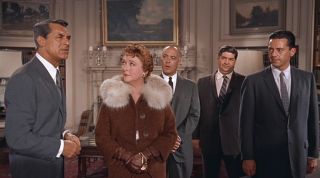The MacGuffin: News and Comment (16/Aug/2008)
(c) Ken Mogg (2008)
August 16
First, several readers spotted that Yves Lavandier ('Writing Drama') almost certainly got it wrong when - as reported here last time - he wrote that there is a lack of urgency in North by Northwest. DF emailed: '(1) Thornhill hasn't got unlimited time to escape his pursuers and prove his innocence - that makes up roughly the first two-thirds of the film and creates a most suspenseful and thrilling atmosphere, IMHO; and (2) at the end the clock really is ticking - Thornhill has to rescue his lady love before that plane takes off!' Quite so. Second, a couple of readers supported my related point, that Hitchcock is about style and sophistication, and that nail-biting 'tension' may be of secondary concern. (It was Hitchcock's privilege not to repeat himself, and each of his films was different. This afternoon I came across what an Australian reviewer wrote in 1976 after she saw Family Plot: that it can't be much good because you don't scream during it! Which is surely to miss the main point of this charming, relaxed valediction, again scripted for Hitch by the thoroughly professional Ernest Lehmann - on whom more below.) Dare I say that sometimes it takes a sophisticated viewer to really appreciate sophistication in a film? In support of the idea that Hitchcock is all about 'tone', SR this week wrote to our 'Seriously Alfred Hitchcock' Group: 'When Hitchcock cast Eva Marie Saint in North by Northwest, he did so because, superficially, he wanted to take her out of the "kitchen sink" realism of Kazan and the Method. But far more interestingly, he cast her because - according to Lehman - he thought that her unusual bone structure suggested an objet d'art, an almost Kabuki-like alabaster mask, hence a perfect trophy for James Mason's urbane, wealthy, duplicitous character who frequents art auctions and has as a backdrop a Frank Lloyd Wright-like house. [In sum,] Hitchcock, again, is telling the story and expressing themes through look, surface, color, even the architecture of a face.' Absolutely! Nonetheless, reader MP expressed tentative agreement with Lavandier's claim that I quoted here last time: 'There is, let's face it, something a little artificial about North by Northwest.' So here's how Lavandier himself sums up his analysis: 'Opinion is divided on North by Northwest, some finding it dated, others declaring it one of the finest films of all time. Opinion is free, but one thing is certain: the script ... is a model of its kind. The whole of the preparation, the way surprise and dramatic irony are exploited, the quality of the construction and the generally simple way the story is told (no flashbacks, no subplot) should be a source of inspiration for any writer of drama.' (p. 442) Let's conclude for this week, then, with some light-hearted frame-analysis (though I want to imply that you could have sophisticated pleasure analysing just about any other frame from this, I think, timeless film). The frame below shows Thornhill momentarily stunned, for where he had expected to find liquor in Townsend's/Vandamm's liquor cabinet, he has discovered only books! This is basically an old situation, with a precedent in Hitchcock's own The Lady Vanishes (1938). But notice the style with which Hitchcock and his team have gone about their business. For one thing, Thornhill has just stepped back athletically from the liquor cabinet, crossing the frame in an instant and making it look perfectly natural, thanks to Cary Grant. (A moment later, the door will open and - cut - 'Mrs Townsend' will enter, as if on cue.) So now we have a row of five complementary 'types' (unobtrusively dominated by a background which signals 'art, money, taste' - the unobtrusiveness being partly due to how the background is just slightly out of focus, and of a neutral salmon-hue). This is where the fun is, essentially. Jessie Royce Landis, playing Mrs Thornhill, dominates the composition, as well she might. My mother, I remember, loved her performance, so spirited and true-to-type: working-class ourselves, we had wealthy neighbours on the corner of our street who rushed to the live production of 'My Fair Lady' and whose kids went to one of Melbourne's top schools. Roger's mother reminds me, a little, of theirs! Mrs Thornhill's thoughtful attire - notice the gold trinket that complements her brown leather gloves which in turn match the rest of her outfit - is subtly opposed to the burly, dumb-looking policeman in the background, swaying out of his ill-fitting suit! Edward Binns as Captain Junket on the right of frame stands tall, but he has been given a grey shirt and a patterned tie that is no match for Roger Thornhill's immaculate white shirt and plain grey silk tie. (Junket's colleague has a standard-issue pink shirt and striped tie, notice.) As for the family lawyer, played by Edward Platt, he is suitably nondescript and ageing (in a film that is about 'life' versus 'death' in nearly every one of its frames). Enough! In Hitchcock's only half-joking words about another of his films: 'Isn't it a fascinating design? You could study it forever!' More about Yves Lavandier's book next time.
This material is copyright of Ken Mogg and the Hitchcock Scholars/'MacGuffin' website (home page) and is archived with the permission of the copyright holder. |

